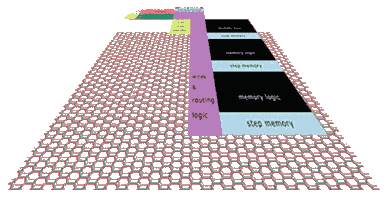The cell matrix is a form of reconfigurable hardware. The underlying hardware of the system is a regular collection of simple processing elements called cells. All cells actually have identical hardware to each other. However, each cell contains a small memory which specifies how that cell's hardware should behave. Hence, one cell may be acting as a piece of wire, another as an inverter, and another as a multiplexer. The specific behavior of the cell is controlled not by the way it was manufactured, but by a changeable memory. It is in this sense that the
hardware is reconfigurable.
Reconfigurable hardware has many advantages over traditional, fixed-function hardware.
Among these advantages are:
optimized: ability to implement algorithms at a much lower level than on a traditional von Neumann architecture, which can lead to greater speed, especially for
massively parallel circuits (see parallel)
|
|
changeable: ability to change the behavior of part or all of the system without physically modifying the hardware
|
|
recyclable: better resistance to manufacturing faults
(see fault tolerant)
|
turnkey: ability to customize the hardware to the specific problem (number, locations, characteristics and interconnection of CPU's, etc.)
|
Reconfigurable devices have been around for decades.
Among the better known varieties are Field Programmable Gate Arrays (FPGAs).
However, a cell matrix is much more powerful than an FPGA, because the
circuits within the cell matrix have the ability to modify their own
structure (see self configurable). FPGAs, on the other hand, require an external controller to direct the reconfiguration operation, and hence
the circuits within an FPGA cannot directly modify themselves.
other features .
core
|
 |

